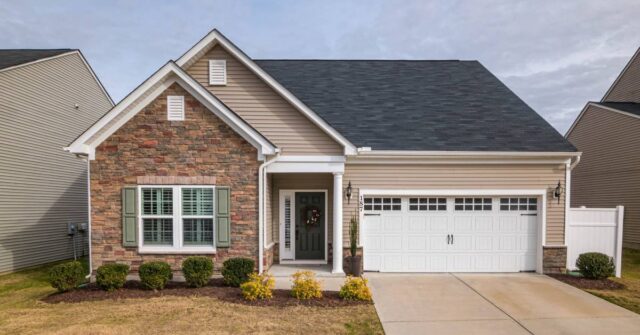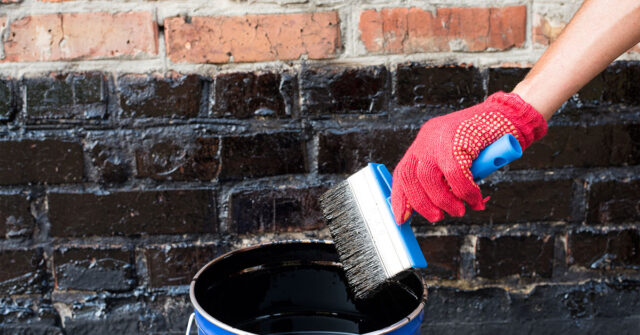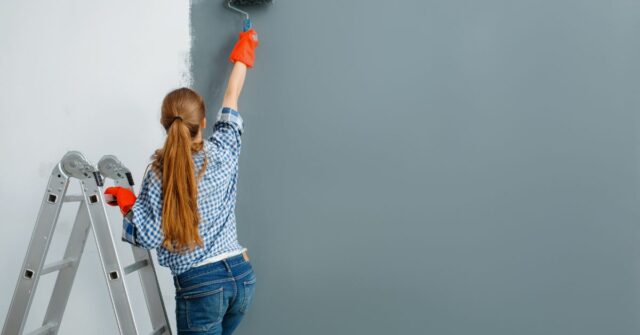The age-old question of whether one can paint over wallpaper is one that many Australian homeowners grapple with.
Wallpaper, once a popular interior decoration choice, can sometimes feel outdated or may no longer fit with a home’s aesthetic.
But is painting over it a viable solution? Let’s dive deep into the intricacies of this topic.
The Quick Answer: Yes, But With Caution
While it’s technically feasible to paint over wallpaper, it’s not as straightforward as just slapping on a coat of paint.
There are various considerations to factor in, especially if you’re aiming for a professional-looking finish.

Understanding the Challenges
Painting over wallpaper presents unique challenges. Unlike painting on a bare wall, wallpaper can have textures, patterns, and adhesives that might interfere with the painting process.
Getting familiar with these challenges is the first step in ensuring a smooth project.
The Role of Wallpaper Material
Not all wallpapers are created equal. Some are porous while others are non-porous, affecting how paint adheres to them.
The material of the wallpaper can make a significant difference in the outcome of your painting project.
Why Would Australian Property Owners Consider This?
In Australia, like elsewhere, changing trends and personal preferences often push homeowners to seek renovations. But why specifically would one consider painting over wallpaper rather than removing it?
A Historical Look at Wallpaper in Australian Homes
Wallpapers have been a significant part of Australian home interiors since the 19th century, especially with British influence on design aesthetics.
As these designs age, modern homeowners might feel the need to update without necessarily going through the labour-intensive removal process.
The Economic Benefits: Save Money and Time
Renovating can be costly and time-consuming. Painting over wallpaper can, in some cases, be a more economical option compared to a complete wall overhaul.
For homeowners on a budget or those looking for a quicker refresh, this approach might be appealing.
Transforming Interiors Without a Complete Overhaul
Complete renovations can be disruptive. Painting over wallpaper offers a middle ground, allowing homeowners to transform spaces without the chaos of full-scale redecorations.
Key Steps to Successfully Paint Over Wallpaper
Should you decide to proceed with this approach, it’s imperative to follow a structured process. These steps will guide you to achieve a finish that not only looks great but also lasts.
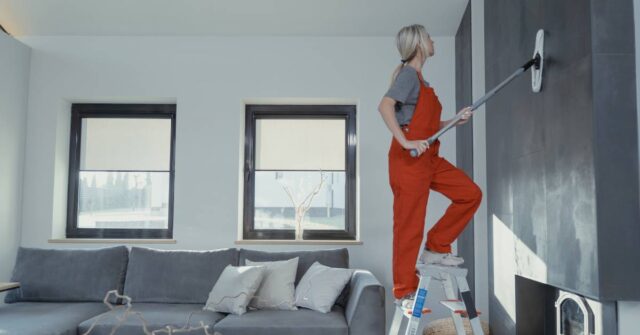
Inspect the Condition of the Wallpaper
Before anything else, the wallpaper’s condition is paramount. If it’s in poor condition, painting might not be the best option.
Looking for Peels, Bubbles, and Tears
Imperfections like peeling edges, bubbles, or tears can compromise the final look. Ensure that the wallpaper is well-adhered to the wall and devoid of noticeable flaws.
Understanding the Adhesion Level
If the wallpaper isn’t sticking well to the wall, adding paint can make matters worse, potentially leading to peeling or bubbling over time. Test the adhesion levels before making a decision.
Prepping the Surface
Like all painting jobs, preparation is key. Here are the steps to prep wallpapered walls:
Cleaning the Wallpaper
Over time, wallpaper can accumulate dust, grime, and oils. Ensure it’s clean by wiping it down with a damp cloth and mild detergent. Let it dry thoroughly before proceeding.
Smoothing Out Imperfections
For wallpapers with textures or visible seams, use fine-grit sandpaper to smooth them out. Remember to dust off any residues before painting.
Sealing with Primer: Why It’s Essential
Applying a primer ensures better paint adhesion and prevents the wallpaper’s colour or patterns from bleeding through. An oil-based primer is recommended for its superior sealing capabilities.
Choosing the Right Paint
Once the wall is prepped, choosing the right paint is critical. Not every paint type will give the desired results on wallpaper.
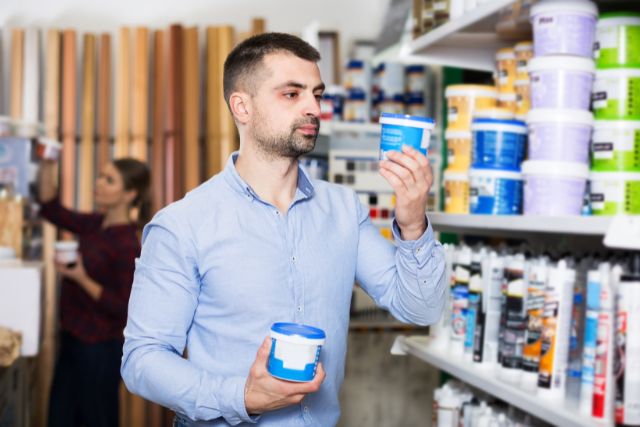
Oil vs. Water-Based Paints
Oil-based paints are generally more durable and adhere better to wallpapers, especially when a primer has been applied. Water-based paints can be used but might require multiple coats for even coverage.
Factors to Consider for the Australian Climate
Australia’s diverse climate – from tropical to temperate – requires consideration. For humid areas, mold-resistant paint might be beneficial. In sunnier locales, UV-resistant paints can prevent premature fading.
Popular Brands and Recommendations
Brands like Dulux and Taubmans offer a range of paints suitable for diverse Australian conditions. It’s advisable to check their specific product lines and consult with local suppliers for recommendations.
Potential Pitfalls and How to Avoid Them
Like all renovation projects, painting over wallpaper can come with its share of challenges. Being aware of potential pitfalls can save you from future headaches.
Unwanted Textures Showing Through
Even with multiple paint coats, heavy textures from the wallpaper might still be visible. If a smooth finish is the goal, consider skimming the wall with a joint compound before painting.
Risk of Peeling or Chipping
If the wallpaper wasn’t adhering well or if the surface wasn’t properly prepped, the paint might peel or chip over time. Always ensure strong wallpaper adhesion and use a primer to minimize these risks.
Issues With Long-Term Durability
Painting over wallpaper might not be as long-lasting as painting on a bare wall. Regular inspections and touch-ups might be necessary, especially in high-traffic areas.
Alternative Solutions to Refreshing Your Walls
If, after weighing the pros and cons, painting over wallpaper doesn’t seem like the ideal solution, there are alternative approaches to consider for a fresh look.

Stripping the Wallpaper
Removing the wallpaper and starting afresh might be more labour-intensive, but it provides a clean slate for any wall treatment.
Step-by-Step Guide
Start by scoring the wallpaper, then apply a mixture of water and vinegar or a commercial wallpaper remover.
Allow it to soak, then scrape off the wallpaper, working in manageable sections. Once all wallpaper is removed, clean the walls and let them dry before painting or applying new wallpaper.
Tools and Materials Needed
You’ll need a wallpaper scorer, scraper, sponge, bucket, and either a homemade or commercial wallpaper-removing solution. Remember to wear protective gloves and goggles.
Overlaying with New Wallpaper
If the existing wallpaper is in good condition, another option is to apply a new layer of wallpaper over it. This can be a quicker solution than stripping the old wallpaper and can offer a fresh new look.
Textured Paint Finishes
For those who want to add dimension to their walls, textured paint finishes can be an alternative. They can mask minor imperfections and add a unique aesthetic to rooms.
Conclusion: To Paint or Not to Paint Over Wallpaper
It’s clear that painting over wallpaper is a viable option for those looking to refresh their interiors without a complete overhaul.
However, the process requires careful consideration, preparation, and execution to achieve optimal results.
For Australian homeowners, weighing the benefits against potential pitfalls, understanding local conditions, and taking inspiration from fellow property owners can lead to a successful and satisfying renovation.

Weighing the Pros and Cons
While painting over wallpaper can offer quick transformations and economic benefits, it’s essential to weigh these advantages against potential long-term maintenance and aesthetic considerations.
Final Recommendations for Australian Homeowners
For those considering this approach, always prioritize thorough preparation and use quality materials. Seek advice from local professionals or suppliers to select the best paint for your specific conditions.
And most importantly, whether you choose to paint, strip, or overlay, remember that every home renovation is a journey. Enjoy the process and the fresh new look it brings!


